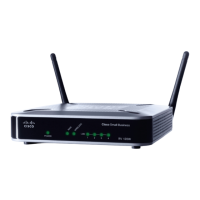Configuring the Wireless Network
Configuring Wireless Profiles
Cisco RV 120W Administration Guide 63
3
Configuring Wireless Profiles
A profile is a set of generic wireless settings that can be shared across multiple
APs. You can create multiple profiles on the Cisco RV 120W, but only one profile is
assigned to each AP at a time.
The Cisco RV 120W provides four default wireless profiles. Even if you are not
going to create custom profiles, at a minimum, you should edit the default profiles
to enable wireless security. See A Note About Wireless Security, page 60.
To configure wireless profiles:
STEP 1 Choose Wireless > AP Profiles.
STEP 2 In the Profiles Table, either click Add to add a new profile, or check the box in the
row of an existing profile and click Edit.
STEP 3 If creating a new profile, enter a unique name to identify the profile.
STEP 4 In the SSID field, enter a unique name for this wireless network. Include up to 32
characters, using any of the characters on the keyboard. For added security, you
should change the default value to a unique name.
STEP 5 Check the Broadcast SSID box if you want to allow all wireless clients within range
to be able to detect this wireless network when they are scanning the local area
for available networks. Disable this feature if you do not want to make the SSID
known. When this feature is disabled, wireless users can connect to your wireless
network only if they know the SSID (and provide the required security credentials).
STEP 6 In the Security field, select the type of security. All devices on your network must
use the same security mode and settings to work correctly. Cisco recommends
using the highest level of security that is supported by the devices in your
network.
• Disabled—Any device can connect to the network. Not recommended.
• Wired Equivalent Privacy (WEP)— Weak security with a basic encryption
method that is not as secure as WPA. WEP may be required if your network
devices do not support WPA; however, it is not recommended.
• Wi-Fi Protected Access (WPA) Personal—WPA is part of the wireless
security standard (802.11i) standardized by the Wi-Fi Alliance and was
intended as an intermediate measure to take the place of WEP while the
802.11i standard was being prepared. It supports TKIP/AES encryption. The
personal authentication is the preshared key (PSK) that is an alphanumeric
passphrase shared with the wireless peer.

